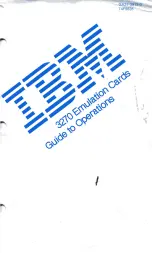
About This Manual
PCI-DIO-96/PXI-6508/PCI-6503 User Manual
x
ni.com
monospace
Text in this font denotes text or characters that you should enter from the
keyboard, sections of code, programming examples, and syntax examples.
This font is also used for the proper names of disk drives, paths, directories,
programs, subprograms, subroutines, device names, functions, operations,
variables, filenames, and extensions.
PPI
x
PPI
x
, where the
x
is replaced by A, B, C, or D, refers to one of the four
programmable peripheral interface (PPI) chips on the PCI-DIO-96 or
PXI-6508. The PCI-6503 contains only one PPI, PPI A.
Your DIO board
Your DIO board refers to either the PCI-DIO-96, PXI-6508, or PCI-6503
board.
Related Documentation
The following National Instruments document contains information that
you may find helpful as you read this manual.
•
Field Wiring and Noise Considerations for Analog Signals
—To access
this document, go to
ni.com/info
and enter the info code
rdfwin
.
•
PCI Local Bus Specification
, Revision 2.1
•
National Instruments
PXI Specification
, Revision 1.0
•
PICMG 2.0 R2.1 CompactPCI
•
Software documentation—Examples of software documentation you
may have are the LabVIEW or LabWindows
™
/CVI
™
documentation
sets and the NI-DAQmx or Traditional NI-DAQ (Legacy)
documentation. After you set up your hardware system, use either the
application software or the NI-DAQ documentation to help you write
your application. If you have a large and complicated system, it is
worthwhile to look through the software documentation before you
configure your hardware.
•
Accessory installation guides or manuals—If you are using accessory
products, read the terminal block and cable assembly installation
guides or accessory board user manuals. They explain how to
physically connect the relevant pieces of the system. Consult these
guides when you are making your connections.










































